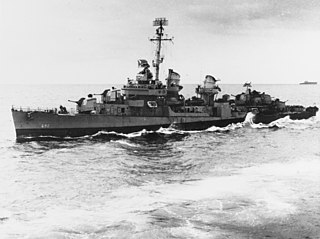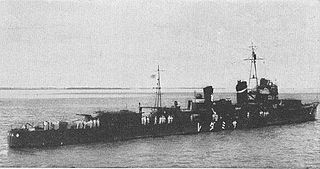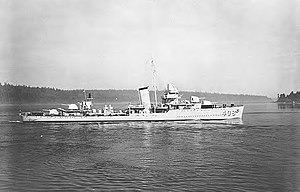
USS Walke (DD-416) was a World War II-era Sims-class destroyer in the service of the United States Navy, named after Rear Admiral Henry A. Walke USN (1809–1896). Walke operated with the Neutrality Patrol in the Caribbean before World War II and fought in the Pacific Theater during the war before being sunk in the Naval Battle of Guadalcanal.

The third USS Farragut (DD-348) was named for Admiral David Glasgow Farragut (1801–1870). She was the lead ship of her class of destroyers in the United States Navy.

Mahan-class destroyers of the United States Navy were a series of 18 destroyers of which the first 16 were laid down in 1934. The last two of the 18, Dunlap and Fanning, are sometimes considered a separate ship class. All 18 were commissioned in 1936 and 1937. Mahan was the lead ship, named for Rear Admiral Alfred Thayer Mahan, an influential historian and theorist on sea power.

The USS San Diego (CL-53) was an Atlanta-class light cruiser of the United States Navy, commissioned just after the US entry into World War II, and active throughout the Pacific theater. Armed with 16 5 in (127 mm)/38 cal DP anti-aircraft guns and 16 Bofors 40 mm AA guns, the Atlanta-class cruisers had one of the heaviest anti-aircraft broadsides of any warship of World War II.

USS Benham (DD-397) was the lead ship of her class of destroyers and the second ship of the United States Navy to be named for Andrew Ellicot Kennedy Benham. She missed the Attack on Pearl Harbor, being an escort for the aircraft carrier USS Enterprise on her way to Midway Atoll at the time. She also served off Hawaii during the Doolittle raid, rescued survivors from several ships, and operated during the Battle of Midway and the landings on Guadalcanal, among other missions. She was torpedoed by the Japanese destroyer Uranami and rendered unusable, for which she was sunk at the end of 1942.

USS Helm (DD-388) was a Bagley-class destroyer in the United States Navy during World War II. She was named for Rear Admiral James Meredith Helm. Helm received 11 battle stars for her World War II service in the Pacific.

The first USS Lang (DD-399) was a Benham-class destroyer in the United States Navy during World War II. She was named after John Lang, a sailor in the United States Navy.

USS Norman Scott (DD-690) was a United States Navy Fletcher-class destroyer named for Rear-Admiral Norman Scott (1889–1942), who was killed in the Naval Battle of Guadalcanal and awarded the Medal of Honor.

USS Grayson (DD-435), a Gleaves-class destroyer, is the only ship of the United States Navy to be named for Rear Admiral Cary Travers Grayson, who served as personal physician and aide to President Woodrow Wilson during World War I. He also served as chairman of the American Red Cross from 1935 until his death on 15 February 1938.

USS Buchanan (DD-484), a Gleaves-class destroyer, was the second ship of the United States Navy to be named for Franklin Buchanan, who was an officer in the U.S. Navy who became an admiral in the Confederate Navy during the American Civil War.

USS Harry E. Hubbard (DD-748), was an Allen M. Sumner-class destroyer of the United States Navy.

USS Lardner (DD-487), a Gleaves-class destroyer, was the second United States Navy ship to be named for Rear Admiral James L. Lardner, a Naval officer during the American Civil War. Lardner received 10 battle stars for World War II service.

USS Forrest (DD-461/DMS-24), was a Gleaves-class destroyer of the United States Navy.

USS Platte (AO-24) was a Cimarron-class oiler serving with the United States Navy, named for the 1836 Platte Purchase that included the Platte Rivers in Iowa, Missouri and Nebraska. Her memorial in Platte County, Missouri honors all four rivers that share the name recorded by Lewis and Clark in 1803.

Samidare was the fifth of ten Shiratsuyu-class destroyers, built for the Imperial Japanese Navy under the Circle One Program.

Chitose (千歳) was a warship of the Imperial Japanese Navy that served from 1938 to 1944, seeing service as a seaplane carrier and later as a light aircraft carrier during World War II. In her initial guise as a seaplane carrier, she first saw service during the Second Sino-Japanese War in 1938, and subsequently played a key role in the Imperial Japanese Navy's development of a network of seaplane bases on the islands of the Pacific Ocean. After the outbreak of World War II in the Pacific, she took part in the Philippines campaign, the Dutch East Indies campaign, the Battle of Midway, and the Guadalcanal campaign, during which she was damaged in the Battle of the Eastern Solomons and also saw service related to the Battle of Cape Esperance.

USS Loeser was a Buckley-class destroyer escort of the United States Navy, named in honor of Lieutenant Commander Arthur E. Loeser (1903–1942).

USS Ringness (APD-100) was a Crosley-class high speed transport that served in the United States Navy from 1944 to 1946. After spending 29 years in reserve, she was sold for scrapping in 1975.

Task Force 44 was an Allied naval task force during the Pacific Campaign of World War II. The task force consisted of warships from the United States Navy and the Royal Australian Navy (RAN). It was generally assigned as a striking force to defend northeast Australia and the surrounding area from any attacks by Axis forces, particularly from the Empire of Japan.



















